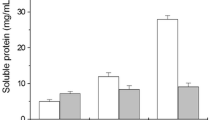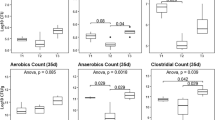Abstract
Due to the ever-increasing demand for meat, it has become necessary to identify cheap and sustainable sources of protein for animal feed. Feathers are the major byproduct of poultry industry, which are rich in hard-to-degrade keratin protein. Previously we found that intact feathers can be digested into free amino acids, short peptides, and nano-/micro-keratin particles by the strain Bacillus licheniformis WHU in water, and the resulting feather hydrolysates exhibit prebiotic effects on mice. To explore the potential utilization of feather hydrolysate in the feed industry, we investigated its effects on the gut microbiota of broilers and fish. Our results suggest that feather hydrolysates significantly decrease and increase the diversity of gut microbial communities in broilers and fish, respectively. The composition of the gut microbiota was markedly altered in both of the animals. The abundance of bacteria with potentially pathogenic phenotypes in the gut microbial community of the fish significantly decreased. Staphylococcus spp., Pseudomonas spp., Neisseria spp., Achromobacter spp. were significantly inhibited by the feather hydrolysates. In addition, feather hydrolysates significantly improved proteolytic activity in the guts of broilers and fish. In fish, the expression levels of ZO-1 and TGF-α significantly improved after administration of feather hydrolysates. The results presented here suggest that feather hydrolysates generated by B. licheniformis WHU could be an alternative protein source in aquaculture and could exert beneficial effects on fish.








Similar content being viewed by others
Data Availability
The data used in this study are available from the corresponding author upon request.
References
Alahyaribeik, S., & Ullah, A. (2020). Methods of keratin extraction from poultry feathers and their effects on antioxidant activity of extracted keratin. International Journal of Biological Macromolecules, 148, 449–456.
Al-Shawi, S. G., Dang, D. S., Yousif, A. Y., Al-Younis, Z. K., Najm, T. A., & Matarneh, S. K. (2020). The potential use of probiotics to improve animal health, efficiency, and meat quality: A review. Agriculture, 10, 452.
Anadón, A., Ares, I., Martínez-Larrañaga, M. R., & Martínez, M. A. (2019). Prebiotics and probiotics in feed and animal health. In R. Gupta, A. Srivastava, & R. Lall (Eds.), Nutraceuticals in veterinary medicine (pp. 261–285). Springer.
Bhari, R., Kaur, M., & Sarup Singh, R. (2021). Chicken feather waste hydrolysate as a superior biofertilizer in agroindustry. Current Microbiology, 78, 2212–2230.
Callegaro, K., Brandelli, A., & Daroit, D. J. (2019). Beyond plucking: Feathers bioprocessing into valuable protein hydrolysates. Waste Management, 95, 399–415.
Coleman, S. W., & Moore, J. E. (2003). Feed quality and animal performance. Field Crops Research, 84, 17–29.
Douglas, G. M., Maffei, V. J., Zaneveld, J. R., Yurgel, S. N., Brown, J. R., Taylor, C. M., Huttenhower, C., & Langille, M. G. (2020). PICRUSt2 for prediction of metagenome functions. Nature Biotechnology, 38, 685–688.
Duman, M., Mulet, M., Altun, S., Saticioglu, I. B., Ozdemir, B., Ajmi, N., Lalucat, J., & García-Valdés, E. (2021). The diversity of Pseudomonas species isolated from fish farms in Turkey. Aquaculture, 535, 736369.
Gryaznova, M., Dvoretskaya, Y., Burakova, I., Syromyatnikov, M., Popov, E., Kokina, A., Mikhaylov, E., & Popov, V. (2022). Dynamics of changes in the gut microbiota of healthy mice fed with lactic acid bacteria and Bifidobacteria. Microorganisms, 10, 1020.
Guinane, C. M., Tadrous, A., Fouhy, F., Ryan, C. A., Dempsey, E. M., Murphy, B., Andrews, E., Cotter, P. D., Stanton, C., & Ross, R. P. (2013). Microbial composition of human appendices from patients following appendectomy. Mbio, 4, e00366-12.
Hassan, M. A., Abol-Fotouh, D., Omer, A. M., Tamer, T. M., & Abbas, E. (2020). Comprehensive insights into microbial keratinases and their implication in various biotechnological and industrial sectors: A review. International Journal of Biological Macromolecules, 154, 567–583.
Isler, B., Kidd, T. J., Stewart, A. G., Harris, P., & Paterson, D. L. (2020). Achromobacter infections and treatment options. Antimicrobial Agents and Chemotherapy, 64, e01025-e1120.
Ke, F., Gao, Y., Liu, L., Zhang, C., Wang, Q., & Gao, X. (2020). Comparative analysis of the gut microbiota of grass carp fed with chicken faeces. Environmental Science and Pollution Research, 27, 32888–32898.
Ke, F., Xie, P., Yang, Y., Yan, L., Guo, A., Yang, J., Zhang, J., Liu, L., Wang, Q., & Gao, X. (2021). Effects of nisin, cecropin, and Penthorum chinense Pursh on the intestinal microbiome of common carp (Cyprinus carpio). Frontiers in Nutrition, 8, 729437.
Korniłłowicz-Kowalska, T., & Bohacz, J. (2011). Biodegradation of keratin waste: Theory and practical aspects. Waste Management, 31, 1689–1701.
Koyanagi, T., Sakamoto, M., Takeuchi, Y., Ohkuma, M., & Izumi, Y. (2010). Analysis of microbiota associated with peri-implantitis using 16S rRNA gene clone library. Journal of Oral Microbiology, 24, 2.
Kyriakis, S. C., Tsiloyiannis, V. K., Vlemmas, J., Sarris, K., Tsinas, A. C., Alexopoulos, C., & Jansegers, L. (1999). The effect of probiotic LSP 122 on the control of post-weaning diarrhoea syndrome of piglets. Research in Veterinary Science, 67, 223–228.
Lei, K., Li, Y. L., Yu, D. Y., Rajput, I. R., & Li, W. F. (2013). Influence of dietary inclusion of Bacillus licheniformis on laying performance, egg quality, antioxidant enzyme activities, and intestinal barrier function of laying hens. Poultry Science, 92, 2389–2395.
Lemes, A. C., Sala, L., Ores Jda, C., Braga, A. R., Egea, M. B., & Fernandes, K. F. (2016). A review of the latest advances in encrypted bioactive peptides from protein-rich waste. International Journal of Molecular Science, 17, 950.
Li, Q. (2019). Progress in microbial degradation of feather waste. Frontiers in Microbiology, 10, 2717.
Li, Y., Liu, M., Zhou, J., Hou, B., Su, X., Liu, Z., Yuan, J., & Li, M. (2019). Bacillus licheniformis Zhengchangsheng® attenuates DSS-induced colitis and modulates the gut microbiota in mice. Beneficial Microbes, 10, 543–553.
Lin, X., Kelemen, D. W., Miller, E. S., & Shih, J. C. (1995). Nucleotide sequence and expression of kerA, the gene encoding a keratinolytic protease of Bacillus licheniformis PWD-1. Applied Environmental Microbiology, 61, 1469–1474.
Meyer, B., Bessei, W., Vahjen, W., Zentek, J., & Harlander-Matauschek, A. (2012). Dietary inclusion of feathers affects intestinal microbiota and microbial metabolites in growing Leghorn-type chickens. Poultry Science, 91, 1506–1513.
Mikx, F., & De Jong, M. (1987). Keratinolytic activity of cutaneous and oral bacteria. Infection and Immunity, 55, 621–625.
Muras, A., Romero, M., Mayer, C., & Otero, A. (2021). Biotechnological applications of Bacillus licheniformis. Critical Reviews in Biotechnology, 41, 609–627.
Pan, X., Yang, J., Xie, P., Zhang, J., Ke, F., Guo, X., Liang, M., Liu, L., Wang, Q., & Gao, X. (2021). Enhancement of activity and thermostability of keratinase from Pseudomonas aeruginosa CCTCC AB2013184 by directed evolution with noncanonical amino acids. Frontiers in Bioenginering and Biotechnology, 9, 770907.
Qi, X., Zhang, Y., Zhang, Y., Luo, F., Song, K., Wang, G., & Ling, F. (2023). Vitamin B12 produced by Cetobacterium somerae improves host resistance against pathogen infection through strengthening the interactions within gut microbiota. Microbiome, 11, 135.
Rahimnahal, S., Meimandipour, A., Fayazi, J., Asghar Karkhane, A., Shamsara, M., Beigi Nassiri, M., Mirzaei, H., Hamblin, M. R., Tarrahimofrad, H., Bakherad, H., et al. (2023). Biochemical and molecular characterization of novel keratinolytic protease from Bacillus licheniformis (KRLr1). Frontiers in Microbiology, 14, 1132760.
Scanes, C. G. (2018). Animal agriculture: Livestock, poultry, and fish aquaculture. In C. G. Scanes & S. R. Toukhsati (Eds.), Animals and human society (pp. 133–179). Academic Press.
Shavandi, A., Silva, T. H., Bekhit, A. A., & Bekhit, A. E. A. (2017). Keratin: Dissolution, extraction and biomedical application. Biomaterial Science, 5, 1699–1735.
Vitali, B., Pugliese, C., Biagi, E., Candela, M., Turroni, S., Bellen, G., Donders, G. G., & Brigidi, P. (2007). Dynamics of vaginal bacterial communities in women developing bacterial vaginosis, candidiasis, or no infection, analyzed by PCR-denaturing gradient gel electrophoresis and real-time PCR. Applied Environmental Microbiology, 73, 5731–5741.
Wang, A., Zhang, Z., Ding, Q., Yang, Y., Bindelle, J., Ran, C., & Zhou, Z. (2021). Intestinal Cetobacterium and acetate modify glucose homeostasis via parasympathetic activation in zebrafish. Gut Microbes, 13, 1–15.
Wang, S., Song, F., Gu, H., Shu, Z., Wei, X., Zhang, K., Zhou, Y., Jiang, L., Wang, Z., Li, J., Luo, H., & Liang, W. (2022). Assess the diversity of gut microbiota among healthy adults for forensic application. Microbial Cell Factories, 21, 46.
Ward, T., Larson, J., Meulemans, J., Hillmann, B., Lynch, J., Sidiropoulos, D., Spear, J. R., Caporaso, G., Blekhman, R., Knight, R., et al. (2017). BugBase predicts organism-level microbiome phenotypes. Biorxiv. https://doi.org/10.1101/133462
Weyand, N. J. (2017). Neisseria models of infection and persistence in the upper respiratory tract. Pathogens and Disease. https://doi.org/10.1093/femspd/ftx031
Wu, L., Lao, X., Wu, Y., Zhang, J., Liang, M., Yang, Y., & Gao, X. (2023). Insights into effects of sodium phytate on gut microbiome of mice by high-throughput sequencing. Biotechnology & Biotechnological Equipment, 37, 2220825.
Wu, L., Ran, L., Wu, Y., Liang, M., Zeng, J., Ke, F., Wang, F., Yang, J., Lao, X., Liu, L., et al. (2022). Oral administration of 5-Hydroxytryptophan restores gut microbiota dysbiosis in a mouse model of depression. Frontiers in Microbiology, 13, 864571.
Xu, Z. R., Hu, C. H., Xia, M. S., Zhan, X. A., & Wang, M. Q. (2003). Effects of dietary fructooligosaccharide on digestive enzyme activities, intestinal microflora and morphology of male broilers. Poultry Science, 82, 1030–1036.
Yi, D., Xing, J., Gao, Y., Pan, X., Xie, P., Yang, J., Wang, Q., & Gao, X. (2020). Enhancement of keratin-degradation ability of the keratinase KerBL from Bacillus licheniformis WHU by proximity-triggered chemical crosslinking. International Journal of Biological Macromolecules, 163, 1458–1470.
Zhang, J., Liang, M., Wu, L., Yang, Y., Sun, Y., Wang, Q., & Gao, X. (2023). Bioconversion of feather waste into bioactive nutrients in water by Bacillus licheniformis WHU. Applied Microbiology and Biotechnology, 107, 7055–7070.
Zhang, Z., Lv, J., Pan, L., & Zhang, Y. (2018). Roles and applications of probiotic Lactobacillus strains. Applied Microbiology and Biotechnology, 102, 8135–8143.
Zhu, S., Han, M., Liu, S., Fan, L., Shi, H., & Li, P. (2022). Composition and diverse differences of intestinal microbiota in ulcerative colitis patients. Frontiers in Cellular and Infection Microbiology, 12, 953962.
Acknowledgements
This work was supported by a Collaborative Fund from Luzhou Government and Southwest Medical University (No. 2020LZXNYDJ29) and a Fund from Southwest Medical University (No. 2021ZKMS045).
Author information
Authors and Affiliations
Contributions
FK, YS, TH: Study design, experiments, and data analysis; YW, SL, and WL: experiments; QW: Writing and revision of the manuscript; XG: Study design, data analysis, writing and revision, and funding.
Corresponding authors
Ethics declarations
Conflict of Interest
The authors declare no conflicts of interest.
Ethical Statements
The animal experiments in the study were approved by the Ethics Committee of Southwest Medical University (No. 20230226-009) and followed the Guidelines for Care and Use of Laboratory Animals of the Southwest Medical University.
Supplementary Information
Below is the link to the electronic supplementary material.
Rights and permissions
Springer Nature or its licensor (e.g. a society or other partner) holds exclusive rights to this article under a publishing agreement with the author(s) or other rightsholder(s); author self-archiving of the accepted manuscript version of this article is solely governed by the terms of such publishing agreement and applicable law.
About this article
Cite this article
Ke, K., Sun, Y., He, T. et al. Effects of Feather Hydrolysates Generated by Probiotic Bacillus licheniformis WHU on Gut Microbiota of Broiler and Common carp. J Microbiol. (2024). https://doi.org/10.1007/s12275-024-00118-z
Received:
Revised:
Accepted:
Published:
DOI: https://doi.org/10.1007/s12275-024-00118-z




